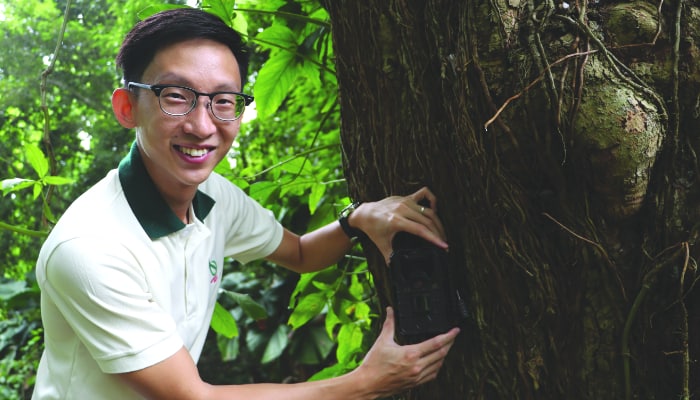A love for animals took NParks Undergraduate Scholarship candidate Shawn on a journey into veterinary and wildlife care.
What Sparked Your Interest in Your Course of Study?
My family had many pets when I was younger, including a dog, two budgies and a few betta fish. When a family has pets, it’s important for everyone to pitch in, so I did my fair share to help take care of them. From this experience, I realised that I enjoyed being around animals and interacting with them, and started to consider becoming a veterinarian. I began reading short stories by James Herriot about the life of a veterinarian working in rural practice. The stories were particularly endearing, and made me even more interested to learn about the job of a veterinarian. I then spent time interning in veterinary clinics in Singapore, getting experience in caring for animals, understanding their basic healthcare needs, and the role of a veterinarian.
What Led You To Consider a Career in NParks?
As an intern, I asked practising clinical veterinarians about possible career paths in their field. I learned about the role that veterinarians play in ensuring public health and animal welfare, and that some veterinarians study emerging diseases from wildlife and help to prevent outbreaks, protecting the health of both animals and people. This led me to find out more about a scholarship offered by the then Agri-Food and Veterinary Authority (AVA) to study veterinary science, with graduates being able to work in disease surveillance and manage animal health programmes. I decided to pursue the scholarship. With the formation of the Animal and Veterinary Service (AVS) under NParks, AVS has since taken up the role of safeguarding animal health and public health, and I was welcomed into the NParks family
What Were Some of the Memorable/Interesting Encounters During Your Course of Study and Why?
The scholarship allowed me to read veterinary science at Murdoch University in Australia. Through this five-year course, I worked with a huge variety of animals ranging from companion pets such as dogs and cats to large farm animals like sheep, cows and horses. As clinical veterinarians in training, we learned a diverse range of skills, becoming anaesthetists, surgeons, dentists and ophthalmologists (and the list goes on) as necessary, so that we could obtain the best outcomes for our furry patients.
In my fourth year, I joined a two-week conservation medicine field trip to South Africa. I got to work with local wildlife veterinarians to tranquilise large game animals such as elephants, giraffes, antelopes and rhinos from a helicopter flying just above the treeline. Once, we had to translocate some elephants that were destroying precious farmland and threatening people’s livelihoods. After tranquilising the animals, we transported them on a huge flatbed truck across several towns. Imagine being a veterinary student riding on the back of a truck with sleeping elephants for over an hour, fully visible to everyone as we drove past – needless to say, we made the cover of the local newspaper the next day! I also got to work with wildlife experts involved in dehorning rhinos to prevent poaching.
These experiences helped to shape my way of thinking about the larger issues of conservation and the illegal wildlife trade, both abroad and here at home. Since then, I have reflected on the role that NParks can play in enhancing liveability for Singaporeans while coexisting with the animals that share our living space.
What Do You Do at NParks’ Wildlife Management Division, and What Are Some of the Projects You Are Currently Working On or Have Worked On in the Past?
As a veterinarian in the Wildlife Management Division, I help to manage human-wildlife interactions. The work is challenging and requires quite a fair bit of thinking on your feet as wild animals are unpredictable. My team also conducts surveys in our green spaces to get a sense of the size of animal populations. This allows us to more effectively manage wildlife, carry out animal rescues, rehabilitate wild animals and keep an eye out for potential pathogens that may impact local populations of animals and possibly have spill-over effects on humans.
Our work in the Wildlife Management Division requires an immense amount of teamwork in order for operations to run smoothly. For example, I was involved in the seizures of 37.5 tonnes of pangolin scales and 8.8 tonnes of elephant ivory in 2019 by NParks. This entailed several work streams such as identification of pangolin species, sampling elephant ivory and moving large shipping containers from point to point. The seizures were a tremendous effort and only possible because the team worked together smoothly and efficiently to ensure that logistical and manpower needs were met.
What advice would you have for those who are exploring their scholarship options?
Signing up for a scholarship is a huge decision as it involves planning for at least the next 9 to 10 years of your life. While passion is important to ensure continued interest in a field of study, in order to stay motivated in the job that follows, it is important that your goals and interests are aligned with the mission of the organisation providing the scholarship. As a scholar in a statutory board such as NParks, your daily responsibilities at work will be in the service of the public, helping to maintain a liveable space for all Singaporeans.
CHIA LEE SHEN, SHAWN
NParks Undergraduate Scholarship
Attained: Bachelor of Veterinary Medicine and Surgery (with High Distinction), Murdoch University
Now: Veterinarian / Wildlife Management
From: Victoria Junior College

